Welcome to the World of Tomorrow
The future isn't something I relish. Even as a child I wasn't too fond of daydreaming about future technology; I was too busy trying to figure out the technology of today. And now that I'm older I've even started back-peddling away from the future in some sick attempt to stave off aging.
However, Chicago's history is steeped in that of the futurists. From hosting several World's Fairs to the Neo-Futurists, we love our expos and speculative technology. I presume it's that reason why Wired brought NextFest, an exposition featuring the future of entertainment, transportation, health, design (just to list a few) to our sleepy little town, hosted in the grand ol' lakeside strip mall known as Navy Pier. But hey, where's a better venue for cutting edge technology than a pier that, at one time, was the largest in the world?
At least for once I, as a Chicagoan, felt special. Sure I've missed every E3, and I've never been among the select few (or had the cash) able to venture out to a Game Developer conferences. But this weekend I'd see robots! And a multitude of different ways to play Pong! And in that respect NextFest didn't disappoint. Unfortunately as a looking glass into the future of electronic entertainment and interfaces, it did.
All in the EyeToy of the Beholder
Out of the 20 or so entertainment-oriented exhibits, at least a quarter of them were focused around reacting to body movement, most notably Playmotion (or Greg Roberts Playmotion!, if you will) and Full Body Games. Playmotion is little more than EyeToy Paint (if such a thing existed). It's a fun canvas of colors, swirls and other sundry algorithms that react in an often psychedelic manner to your movements. It's quaint, but lacks depth.
Full Body Games actually felt like it was powered by an EyeToy. You stand in front of a screen and admire the silhouette of your body replicated displayed on the video feed. In the game we saw, blocks were thrown either at your shadow's head, or its knees and you had to either duck, or hop to avoid them. Get hit enough times and, that's right, game over. Amusing enough, but again nothing the EyeToy couldn't handle.
The Virtual Air Hockey table was missing a shadow version of yourself playing, but the concept was the same. Wave your hand over a projected image of an air hockey table and go head to head against a fierce eight-year-old competitor. This kid was pretty severe (the one in the blue), and hardcore - his victory dance was accompanied by an extreme display of teeth gnashing and fist pumping. The physics of the puck were rather specious, but it was an absorbing game. Of course it is, it's air hockey!
Now, imagine Soul Calibur or Street Fighter utilizing an EyeToy and you might get Kick Ass Kung Fu. Your ghastly visage is imaged into the game, and you're given the opportunity to beat the living heck out of George W. Bush, or a number of other opponents. I hear Sega Superstars for the EyeToy allows you to basically do the same, but against Virtua Fighter opponents! And you get the added bonus of the first Samba de Amigo game available since Samba de Amigo 2000!
Tennis for Two (and Three, and Four)
While we were knee-deep in the thick of the expo, unitdaisy remarked how funny it was that every gaming device seems to start at Pong, and works its way up. It makes sense - Pong (or table tennis) is so exceedingly simple just the bare bones of competitive conflict (that happen to be easily visualized): Two blocks and a circle. Many of the exhibits, including the virtual air hockey display were nothing more than glorified Pong games. Not that there's anything wrong with that. In fact, one exhibit showed how you can take such a simple concept and turn it on its ear: Brainball.
The title says it all: two players use their brain to move a ball towards each others goal. The spin? Instead of paddles, the ball is controlled not by directed thoughts, but by a lack of thought. The Zen of Pong, so to speak. The player who's able to clear their head is the winner, represented by the ball coming to a halt in the opponent's goal. One intriguing matter of note was that when people actually played the game, they did so with their eyes closed. Now, while I understand that you would probably want to shut out visual stimuli, that's virtually unprecedented concerning a game, and shows how ultimately the physical display of the magnetically driven ball is more for the audience's entertainment than the participants.
If you liked your Pong a bit more traditional, there was a Pong floor show that allowed up to four players. The twist? You controlled the paddles standing, using your feet to control your paddle while staring at the illuminated floor that more than slightly resembles a tacky disco club floor. Tacky, yet retro-chic. The scoring system was the most novel aspect of the game, being incorporated into the 'corner walls': for each ball you missed, one of the four corner blocks would light up. Numerals be damned!
Life Through a Handheld Lens
One of the more enticing demos was that from The Graz University of Technology with their 'Handheld Augmented Reality' project. For those that saw that widely-circulated Total Immersion demo, it's similar to that but utilizes a handheld. While the 3D models weren't nearly as impressive as Total Immersion's, the exhibit gives us a virtual reality that's viewable through your standard Pocket PC handheld. Objects that go unseen by the human eye roam the earthen terrain with just a few flicks of a stylus, in this case a train transverses the blocks arranged on a table through the eye of this PDA.
Of course, no futurist exhibit would be complete without a virtual reality exhibit. These honestly seem to get worse and worse as time passes on. NextFest's VR show felt no better than a Lawnmower Man tech demo merged with the cheap 3D tech that inspired such cinematic classics as Bwana Devil and Jaws 3D, complete with crassly abstract images and a vastly sparse green field. It's fun to wear 3D glasses though, a point I'm sure was not lost on Robert Rodriguez.
Re-enacting Pac-Man in 3D however, looked like not so much fun. An imposing, and surely weighty pack was strapped to your back and you stumbled (those partaking of the experiment appeared to be taking 'baby steps' throughout the entire ordeal) while they 'gobbled' dots. I think out of sheer mercy the overseers of the event decided to restrain the ghosts, as I honestly can't imagine someone running with that hunk of electronics on their back.
Kill Screen-cheaters Dead
Out of all of exhibits, the following seemed the most practical from a video game standpoint: a television screen that restricted viewers on the sidelines from seeing exactly what you were seeing. An example: a poker game was being played, but only each player could see their cards; other players would see nothing but the backs of their opponents cards. The potential to no longer have to fret about screen-cheaters is alluring, is it not?
Grip the Future in Your Hands
Lastly, you can't neglect the tactile shows. Interfaces requiring you to actually touch something physical was quite rare on the show floor, but not non-existent. For example, one interface had a watery experience very similar to this year's E3 PlayStation 3 EyeToy demo: pouring water from one container to another. Entitled Sound Flakes, you'd displace water in collusion with specific faucets and ... well, let's just say it's the kitchen sink equivalent of a light-machine and leave it at that. Then there's BlowAway, a cooperative game requiring lungfuls of air forced through your mouth and into a giant plastic flower, which would in turn send a balloon towards a target. Perhaps it'll make its way to the Nintendo DS sometime in the near future.
It's great to see strangers acting together towards such a goal, but could it be in a bit more stern of a manner?
We can't forget Virsual, the digital rocking horse. The name is pretty descriptive, but essentially the rocking motion you make by straddling a two-foot tall, four-legged creature was recreated on the screen in front of you. Those of you whom expunged your meals while watching Breaking the Waves may see where I'm going here - if there's one sure-fire route to nausea and bile, it's this way.
Now the Music Box, this something I can sink my teeth into. You twiddle on a laptop to toggle the notes on the box's spindle and then crank the box, invoking the music boxes of old. It's a brilliant concept that melds both the old and new in a newly tactile and visual experience.
What Happened to Tomorrow?
When I read that Wired's NextFest would be featuring 'the future of entertainment technology', I had hoped it would shed some light on the future of video games. Actually, it appears that the exact opposite occurred - most of what was on display appears to have its roots in already available, mainstream gaming peripherals, such as the EyeToy. While Brainball and the 'Handheld Augmented Reality' exhibits proved that there was some innovation on display. Even if they were rather crude examples, each showed that the gaming's next big step may lay in combining the intangible with the tangible. However, other than those two examples NextFest's vision of entertainment's future was slightly disheartening.
Perhaps this is why innovation increasingly appears to come via software, instead of hardware. After all, Handheld Augmented Reality's utilized hardware we already use (Pocket PC/Windows CE devices). Brainball's peripheral device is one constantly in use, and available to everyone: the brain. The genius of these systems is that they're taking something we use every day, and utilizing it in an uncommon manner. Are either of these systems 'video games'? It depends on your definition of videogame, but Brainball appears to transcend video games, becoming a new type of head-puzzle (despite the fact that it certainly is algorithmic entertainment), and Handheld Augmented Reality's whole shtick is superimposing fake images onto real images via a video screen and camera. Both systems brought something other than novelty to the show, whereas many of the 'entertainment' exhibits were unable to break those shackles. Novelty is all well and good, but something we have more than enough of in the video game world already.
While I may not be as bold as to make my own futurist claims, I feel comfortable in saying that the future of gaming is not that of novelty - if we wanted that we could take a trip to the carnival. It's about creating a more evocative, immersive, intense and innovative experience. We aren't willing to make a trade-off where we have immersion but lack intensity and evocative matter such as messing around with injecting a 3D likeness of ourselves into a game (besides, you can already do that with Tony Hawk Underground and an (you guessed it) Eyetoy). We require all of the above, and if we don't receive that then the platform is nothing but a bauble. And while toys are all well and good, we should really aim higher with our bleeding-edge entertainment.



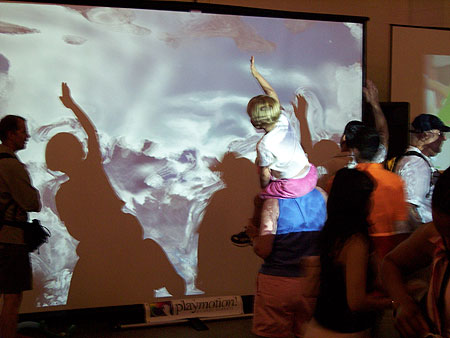
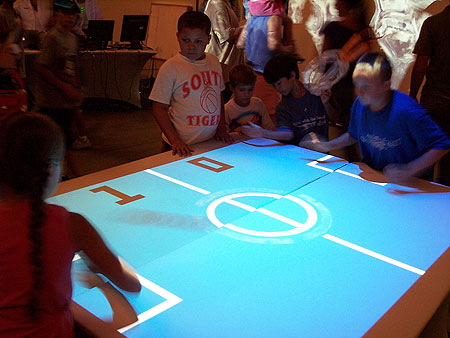
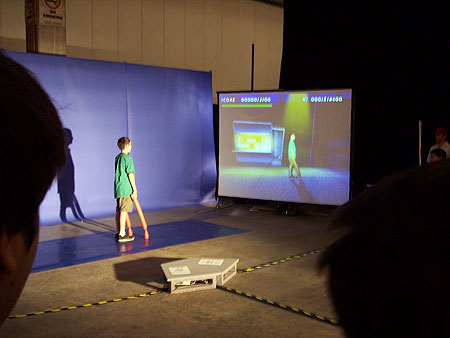

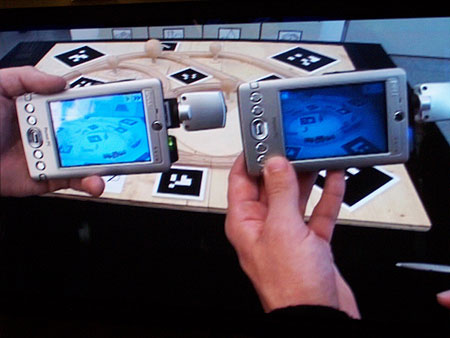

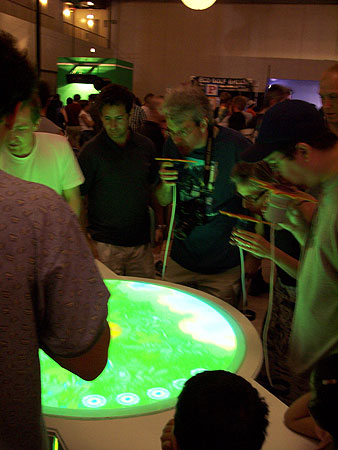


#1 hobbie Jul 11, 2005 03:53am
Seems like a bunch of nicnacks....